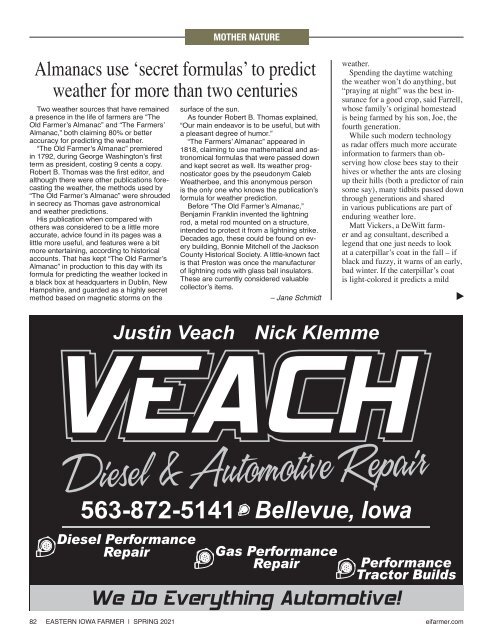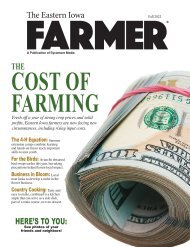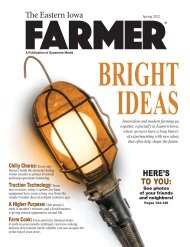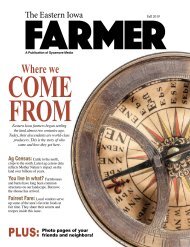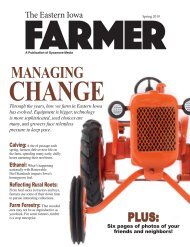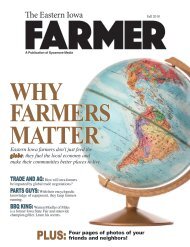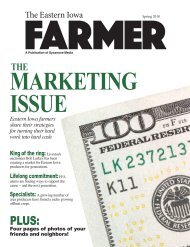Eastern Iowa Farmer Spring 2021
Create successful ePaper yourself
Turn your PDF publications into a flip-book with our unique Google optimized e-Paper software.
mother nature<br />
Almanacs use ‘secret formulas’ to predict<br />
weather for more than two centuries<br />
Two weather sources that have remained<br />
a presence in the life of farmers are “The<br />
Old <strong>Farmer</strong>’s Almanac” and “The <strong>Farmer</strong>s’<br />
Almanac,” both claiming 80% or better<br />
accuracy for predicting the weather.<br />
“The Old <strong>Farmer</strong>’s Almanac” premiered<br />
in 1792, during George Washington’s first<br />
term as president, costing 9 cents a copy.<br />
Robert B. Thomas was the first editor, and<br />
although there were other publications forecasting<br />
the weather, the methods used by<br />
“The Old <strong>Farmer</strong>’s Almanac” were shrouded<br />
in secrecy as Thomas gave astronomical<br />
and weather predictions.<br />
His publication when compared with<br />
others was considered to be a little more<br />
accurate, advice found in its pages was a<br />
little more useful, and features were a bit<br />
more entertaining, according to historical<br />
accounts. That has kept “The Old <strong>Farmer</strong>’s<br />
Almanac” in production to this day with its<br />
formula for predicting the weather locked in<br />
a black box at headquarters in Dublin, New<br />
Hampshire, and guarded as a highly secret<br />
method based on magnetic storms on the<br />
surface of the sun.<br />
As founder Robert B. Thomas explained,<br />
“Our main endeavor is to be useful, but with<br />
a pleasant degree of humor.”<br />
“The <strong>Farmer</strong>s’ Almanac” appeared in<br />
1818, claiming to use mathematical and astronomical<br />
formulas that were passed down<br />
and kept secret as well. Its weather prognosticator<br />
goes by the pseudonym Caleb<br />
Weatherbee, and this anonymous person<br />
is the only one who knows the publication’s<br />
formula for weather prediction.<br />
Before “The Old <strong>Farmer</strong>’s Almanac,”<br />
Benjamin Franklin invented the lightning<br />
rod, a metal rod mounted on a structure,<br />
intended to protect it from a lightning strike.<br />
Decades ago, these could be found on every<br />
building, Bonnie Mitchell of the Jackson<br />
County Historical Society. A little-known fact<br />
is that Preston was once the manufacturer<br />
of lightning rods with glass ball insulators.<br />
These are currently considered valuable<br />
collector’s items.<br />
– Jane Schmidt<br />
weather.<br />
Spending the daytime watching<br />
the weather won’t do anything, but<br />
“praying at night” was the best insurance<br />
for a good crop, said Farrell,<br />
whose family’s original homestead<br />
is being farmed by his son, Joe, the<br />
fourth generation.<br />
While such modern technology<br />
as radar offers much more accurate<br />
information to farmers than observing<br />
how close bees stay to their<br />
hives or whether the ants are closing<br />
up their hills (both a predictor of rain<br />
some say), many tidbits passed down<br />
through generations and shared<br />
in various publications are part of<br />
enduring weather lore.<br />
Matt Vickers, a DeWitt farmer<br />
and ag consultant, described a<br />
legend that one just needs to look<br />
at a caterpillar’s coat in the fall – if<br />
black and fuzzy, it warns of an early,<br />
bad winter. If the caterpillar’s coat<br />
is light-colored it predicts a mild<br />
82 <strong>Eastern</strong> <strong>Iowa</strong> <strong>Farmer</strong> | <strong>Spring</strong> <strong>2021</strong> eifarmer.com


